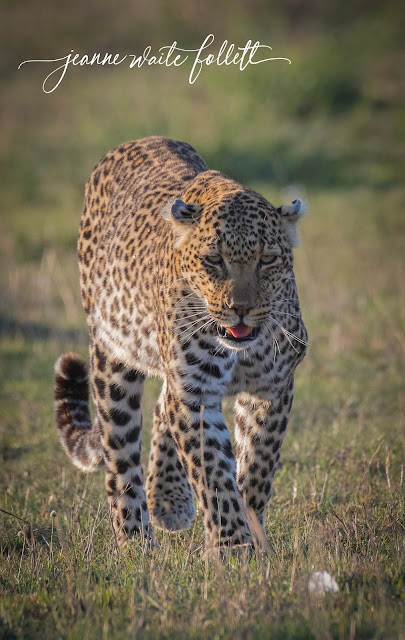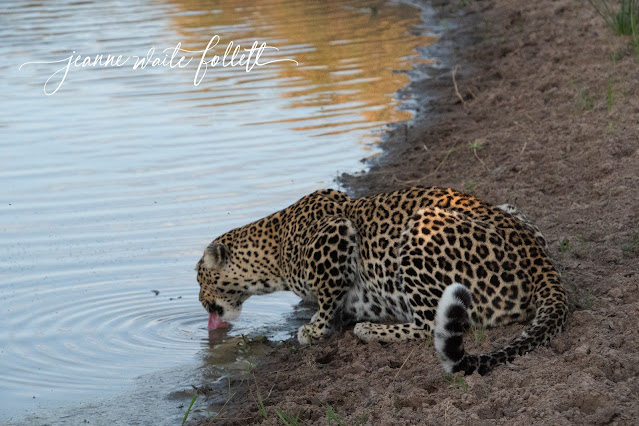Chapter 23:
In Which We Contemplate
the Leopard
“Those who have never seen a leopard under favorable conditions in his natural
surroundings
can have no conception of the grace of movement, and beauty of
coloring,
of this the most graceful and the most beautiful of all animals...”~
Jim Corbett
We eat lunch outdoors under a tree and savor an exquisite dessert called a Chocolate Mug, a rich chocolate and Amarula combination. Amarula is a creamy liqueur made from an emulsion of fruit from the Marula tree, cream and sugar. Elephants love the fruit and so do we in its liqueur form, preferably a double over the rocks.
It is our tradition to have Amarula over ice at least once to celebrate friendship and a trip to this continent. To also find it in a dessert is delightful because not only is its taste pleasing, it doesn't count as a drink so we can still have that.
Downtime after lunch enables us to get unpacked and settled into our tents. We will be here six nights and it is an incredibly relaxing feeling knowing that we won't have to pack and move in two days.
Then, at four o'clock, it's time to head out, over the termite bridge as I took to thinking of it, into the Toyota Land Cruiser, and away we go to explore this relatively remote area of the Maasai Mara. The Mara, as it is called for short. comprises 583 square miles of grassland savannah, seasonal rivers, and acacia trees. It is an extension of the greater Serengeti across the border in Tanzania.
Adding to the total area are a number of privately-owned conservancies that border the north side of the Mara. Everything is unfenced and that allows the animals more room to roam.
 |
| Typical of this area of the Mara. |
Our guide drives the Land Rover uphill on what is basically a Jeep trail, two tire tracks winding around natural obstacles like rocks, trees, and large bushes. Most of these trails are not maintained by heavy equipment. If any repairs are needed, they are done by hand with a spade, perhaps using a pickup to haul gravel from one place to another.
While we were lounging around in our tents after lunch, at least one guide was out looking for game. He'd spotted a leopard and the guides are "hard-wired for leopards," as Marg calls it, and from my observations I think she is 100 per cent correct. They will drop everything to show us a leopard. But to be fair, their clients love leopards also.
It becomes a Ferrari Safari, another term I learned from Marg. Bouncity-bouncity-bounce we we fly across the Mara with us in the back like ping pong balls in a wind tunnel.
Then we come to a road block. Three safari vehicles block the road next to a small herd of elephants.
It's hard to know what's being discussed when the guides pull up driver-window-to-driver window because they speak Swahili. There's a polite greeting and then, we are told, they exchange information about game sightings. The guides use this method frequently. They also used to radio information but that seems to have changed to cell phones and there is extensive use of phones. You don't know if they're relaying info or playing Candy Crush but it's best to give them the benefit of the doubt.
I once wondered silently about the amount of time a guide spent on his phone while we were stopped looking at game and it turned out he was looking up the name of an unfamiliar bird FOR ME.
About the time the conversation breaks up and the vehicles pass, the elephants decide to cross the trail.
Elephants always have th ight of way!
When they pass, we are back to Ferrari Safari mode. The trail is a bit better up here in the grasslands but it is still bumpy. Added to that, it seems the flies of the Mara can fly as fast as a Ferrari can drive.
 |
| Flies on the head of our guide. |
On we rocket until the driver stops the vehicle and calls another guide for directions. A change of trails and we soon find the leopard's prey stashed under a bush, but no leopard.
We track along the creek, looking in all the greenery for the tell-tail spots.
The guides spot some lions resting in the shade of bushes in the same direction we are going so we stop for photographs while the other vehicles look for the leopard.
The sun comes out from behind the clouds and the light gets much better.
And then there she is, walking across the grasslands like she's the only creature out there.
She doesn't even look at the zebras as she passes them, but the zebras watch her carefully.
 |
Note how powerfully built she is. Leopards have strong muscles in their necks and shoulders that enable them to carry a prey animal equal to their own weight up a tree. They do this to keep it safe from others animals that will steal it, like hyenas, lions, etc.
|
While the leopard walks right past the vehicle, Marg explains to the driver where she wants him to position the truck.
They know photographers like to get head-on shots.
This leopard is known as Lorian. The precise identifying marks are the necklace--the string of black spots on her neck. I'm not sure how the guides recognize the different leopards. Probably because of where they find them and because they see them so often.
They animals are habituated to the vehicles. After many years, they know the Land Rovers are not a food source nor are they predators. Now, they seek shade under them and use them as a blind to get closer to prey animals.
I was gobsmacked the first time a leopard walked under the vehicle right where I was sitting. I did, however, have the wherewithall to carefully lean over the window opening and get a shot of the animal coming out, which put me about two feet from a wild cat.

Afternoon game drives are short--only about two hours. By now the light is fading, the sun is setting, and itias time for some animals-on-the-horizon-in-the-sunset. Of course, it isn't anywhere near as dark as it seems in the following photos but magical things happen when you point a camera in the direction of a light source.
 |
Overall, this is not a good photo because I cut off the head of the wildebeest on the left. I shouldn't post it here but I am because I really like what-could-have-been. It isn't often that wildebeests will pose like this.
|
And one more of wildebeest and Thompson's gazelle. Then, back to camp.
Next: the cheetah and her five cubs
























Really enjoyed the lion cubs (photos 6 - 10) great photos. Nice photos of Lorian the leopard (photos 11 - 20). I know how you feel (photo 23) about some photos as I too wrestle with less that perfect shots that I still want to show. The end of the day photos are also very nice. So too is the fact that : We will be here six nights and it is an incredibly relaxing feeling knowing that we won't have to pack and move in two days. Smiles Cap and Patti.
ReplyDeleteGreat photos and story line. did find a bit of a mistake. You are riding in a Toyota Land Cruiser, not Rover. I sure wish I could do one of these trips. Love all the wildlife.
ReplyDelete